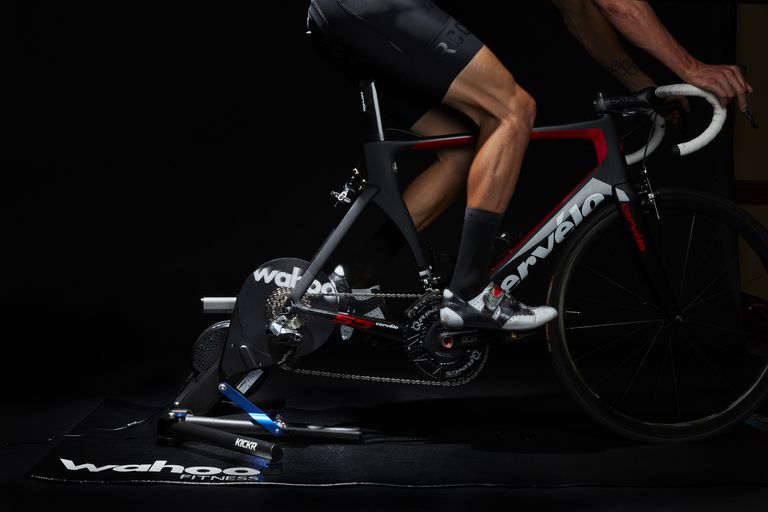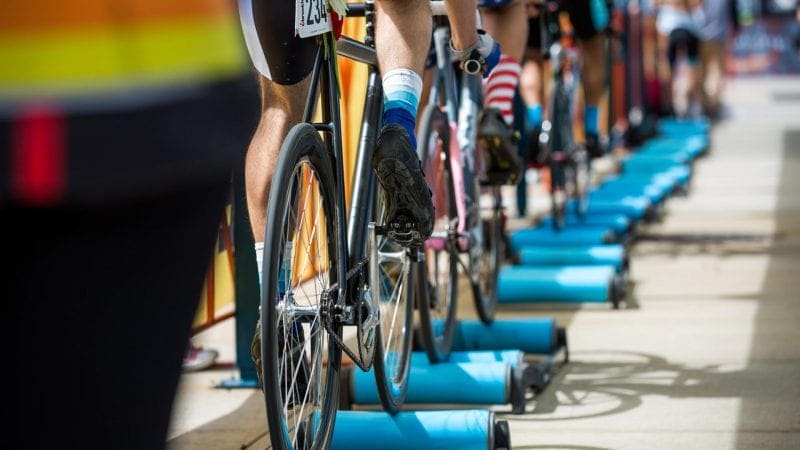Winter is coming and you’re after a trainer so you can ride indoors with others on Zwift or do structured training on Training Peaks. There are many bike trainers on the market today ranging from $100 all the way to $1,000.
- What do you need to know before buying?
- What’s the difference between a cheap and expensive trainer?
- Do you need smart trainers for Zwift?
- Are they noisy that you might wake up the family?
- Is it compatible with your current bike?
…and many more questions you might have.
On this page, I’ll answer all these questions, and hopefully, by the end, you can make a more informed decision on which bike trainer suits you best.
Let’s jump straight in.
On This Page
Types of Bike Trainers
You’d probably have noticed there are different types of bike trainers. Here we take a deeper look into the 2 most commonly found types of bike trainers and how they compare against each other.
| Trainer Type | Size | Ride Feel | Cost |
|---|---|---|---|
| Wheels-on | Smaller footprint, weighs less | Occasional wheel slippage especially with high power outputs | $$ |
| Direct Drive | Larger footprint, significantly heavier | Smooth power transfer and road-like feel | $$$$$ |
Wheels On Trainers
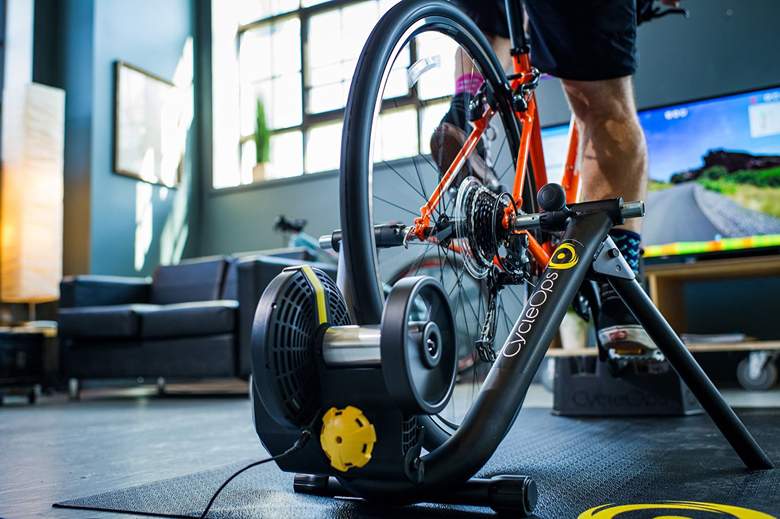
The benefit of the wheels on a bike trainer is that drivetrain compatibility is a non-issue. All you need to do is clamp your rear wheel onto the trainer.
Another significant benefit is the wheels on design tend to cost far less than their direct-drive trainers counterparts. This is because you don’t need to purchase an extra cassette.
Wheels on trainers are also smaller in size and weigh lesser. This is a significant benefit because they can be quickly stored with ease when not in use.
What about the downsides?
The main downside of a wheels-on trainer is the occasional wheel slippage. Generally, slippage occurs during high-intensity efforts which can affect your training session and keep you less engaged. You’ll also need to run a slightly lower tire pressure and ensure that there’s just enough contact between the tire and the trainer wheel.
These days, there are various bike trainer tires that are designed specifically for a wheels-on trainer. They are thicker and more durable compared to standard road bike tires.
Some of the popular wheels on trainers include the Tacx Flow, Wahoo Kickr Snap (a smart trainer), Sportneer, or the Saris Mag.
Geek Tip : Wheels on trainers are ideal if you’re just starting out, have a tight budget and won’t be doing any hard efforts on the trainer.
Direct-Drive Trainers
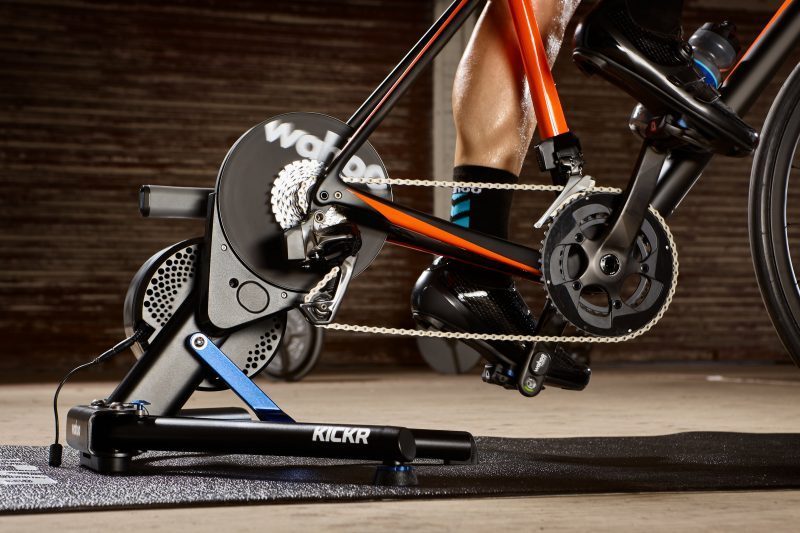
Direct-drive trainers have a realistic (or close to) road feel.
There is no tire slippage unlike the wheels on bike trainers since the rear tire is removed entirely and the frame is connected directly with the trainer.
You’ll able to step up your efforts while remaining completely engaged with smooth pedal strokes during your workout without the occasional hiccups that are found on the wheels-on trainer.
Keep in mind that while you can do hard efforts on the direct-drive trainers, you don’t want to be sprinting or doing any off-the-saddle pedaling on it to minimize the risk of damaging your bike frame, especially if it’s carbon!
The convenience of smooth power transfer comes at a price. Direct drive trainers such as the Elite Drivo 2 and Wahoo Kickr are much more expensive than wheels on trainers because of their increased technological features.
They’re also more cumbersome because of their more intricate design. This added weight makes storage and transport more difficult.
Geek Tip : Direct-drive trainers are ideal if you’re looking to do sustained, medium to hard efforts training.
Types of Resistance
Fluid Based
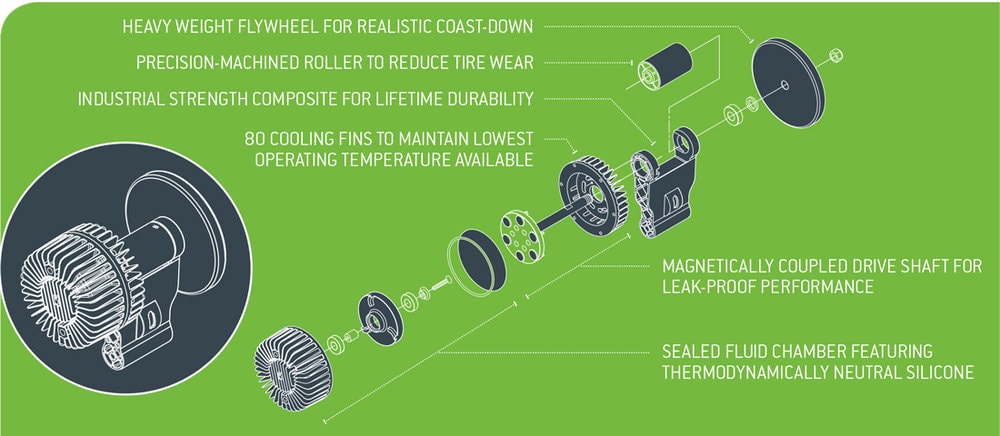
Fluid resistance trainers offer resistance by implementing an impeller (blade) within a bath of liquid.
As the wheel speed increases, so does the resistance. Fluid trainers mimic the riding outdoors experience because the resistance is variable.
If you spin in an easy gear, the fluid trainer offers little resistance, but if you jump into a harder gear, the resistance will quickly build up.
Manufacturers of fluid trainers generally utilize thermodynamically neutral fluid, such as medical-grade silicone, so that the fluid doesn’t absorb heat while you ride. This keeps the resistance you produce at a consistent level, every time. Connected to the fluid chamber is the drive system. This is either directly plugged into the chamber or magnetically attached. The drive system consists of the flywheel and a roller for your rear wheel to coast on.
As you pedal and increase your power output, the fluid system works simultaneously with the drive system to create that real-road feel.
The Kurt Kinetic Rock and Roll and Saris Fluid 2 trainer are some of the popular wheels-on bike trainers that uses fluid resistance.
Magnet Based
Magnetic trainers generate resistance by spinning a metal disk through a magnetic field. This magnetic unit creates a drag on the rear wheel as it turns from your power output.
A magnetic trainer’s drive unit consists of a flywheel with opposing magnets that replicates the momentum of the rider on a bike and a roller where the rear tire spins.
The metal disk that spins through the magnetic field is affected by what is known as an Eddy Current. This current is what is responsible for the drag that’s produced on the rear wheel, effectively creating progressive resistance.
Magnetic trainers produce high amounts of heat throughout a workout session. As heat increases, resistance decreases. Some magnetic trainer models offer small fans to dissipate heat to keep resistance at an optimal and realistic level.
The Saris Mag trainer is a good example of a wheels-on magnet-based trainer.
Wind Based
Wind trainers are possibly the most basic design when it comes to indoor trainers.
Wind trainers create resistance by creating air. The roller that the wheel spins on is connected to a large disk that consists of blades.
As the rider produces power, the blades spin and creates wind resistance. The progressive resistance increases as you pedal harder. These models are known to be extremely loud due to the wind-generated, especially during high-intensity efforts.
The resistance offered by wind trainers does have a limit once higher power levels are reached. The fans can only provide a certain amount of resistance, which makes them best for endurance-like efforts.
Interactive Trainers
Interactive trainers provide dynamic resistance control through the use of sensors and power meters located on the trainer. These sensors communicate with apps on your phone or laptop and give you the most realistic resistance according to the specific parameters that you choose.
How does interactive trainers work?
Resistance works through a power meter located inside the smart trainer. The trainer broadcasts all power data to your preferred training app like Zwift.
If you’re riding hills climbs with a 10% grade in the virtual training world of Zwift, the app communicates this to your trainer, and it automatically makes the resistance similar to its algorithm.
If you begin riding downhill, the smart trainer releases all resistance, and you must shift accordingly to regain any resistance to increase your speed.
Through smart trainers and their associated apps, you can choose to set training plans of set power data ranges. If you want to train at 200 watts for one hour, the electromagnetic hub locks in at 200 watts and gives the specific resistance automatically, no matter how hard you pedal.
Read More : 4 Cycling Analytics Softwares Favored by Cyclists
Most smart trainers are direct drive based, and resistance is produced in its electromagnetic hub. This electromagnetic hybrid creates a low decibel and heat-resistant atmosphere.
The most popular smart and interactive trainers in the market today for Zwift are the Wahoo Kickr and Tacx Neo.
Read More : Wahoo Elemnt vs Bolt vs Roam – What’s the Difference?
Bike Compatibility
When looking for a bike trainer, you’ll need first to check if the trainer is compatible with your current bike. Knowing beforehand if a bike trainer is compatible is the difference between starting your indoor training immediately or being frustrated staring at a trainer that you can’t use.
Generally, wheels on trainers can fit almost all bikes, regardless whether its rim or disc brakes. If you’ve a bike with disc brake, you might want to check if it’s supported.
For a bike with disc brakes, you’ll need a trainer with thru-axles as the method for mounting it.
Geek Tip : Most new (post 2017) direct-drive trainers can support bikes with rim and disc brakes, and various wheel sizes through the use of adapters.
Noise Levels
Noise levels play a significant role when considering which bike trainer to buy. This is because not all trainers are created equal, and not all living situations allow for loud trainers.
- The quietest type of trainer is the fluid-based trainer. The thermodynamic fluid located within its chamber doesn’t retain heat, which keeps the noise at a minimum while you’re on your trainer. This style is a must if you’re living in a small space or others around you need peace and quiet.
- The second quietest type is the magnetic-based trainer. Although these generate heat and necessitate a fan, the noise produced is manageable. If you don’t need absolute silence but also want to hear your surroundings, then a magnetic-based trainer will do just that. Since magnetic trainers are in the middle, it’s up to you to consider all other factors if you’d like to spend a little extra to get the benefits of a fluid trainer.
- The loudest type of trainer is the wind-based models. These produce resistance through large fans that create wind. If your living situation allows for high decibels, then this is an option.
Although more recent models are becoming quieter, they are still the loudest option. Alternatively, you can also use a bike trainer mat to reduce noise levels.
Geek Tip : Noise level increases as you go from fluid to magnetic and wind based trainers.
Overall Weight
Trainers can weigh anywhere from 5kg all the way up to 20kg+. It all depends on the design, resistance type, and how solid the build is.
- The lightest option is the wind-based trainer. This trainer style weighs the least out of the others because they are based on a straightforward design. The disc with blades also acts as a flywheel, so there are fewer components that add weight.
- In the middle is the magnetic-based trainer. The resistance unit consists of a flywheel and a magnetic hub.
- The heaviest option of the three is the fluid-based trainer. These tend to be the heaviest because of the fluid located within a chamber to offer resistance and reduce heat absorption.
Geek Tip : Weight increases as you move from wind to magnetic and fluid-based trainers.
Size, Footprint and Storage Space
Just like in the previous category, weight plays a significant role in a trainer’s size and ease of storage. Anyone considering a bike trainer should think how they’ll store their trainer after a training session.
- Wind-based models are smaller and easier to store. The vast majority of wind trainers can fold up for easy packability.
- Magnetic trainers are once again in the middle. These trainers are usually foldable, but due to their added components, their size is larger than the wind-based trainers.
- Fluid trainers are slightly larger than magnetic trainers and therefore are third in this category. These trainers are generally foldable so storage is very possible, but its additional weight doesn’t allow for the highest marks in size and storage.
Pricing Point
The price point is possibly the biggest factor to consider before buying a trainer. Some of us are on a budget, whereas others don’t mind the price tag at all. Depending on where you land on this spectrum, this category will determine which model you’ll eventually buy.
When it comes to bike trainers, one thing is sure; the more features available equates to a higher price. The pinnacle in price lands can be found with smart trainers. These have endless functions and features and have a significant price tag to match.
Beginner to mid-level smart trainers like the Elite Direto usually starts from $700, while some high-end models like the Wahoo Kickr and Tacx Neo are in the $1,000+ range.
Fluid trainers are the second most expensive models, third is magnetic-based models, and the least costly are wind-based trainers.
Geek Tip : Expect to pay upwards of $700 for a smart, direct drive trainer.
Author Recommended Reads

